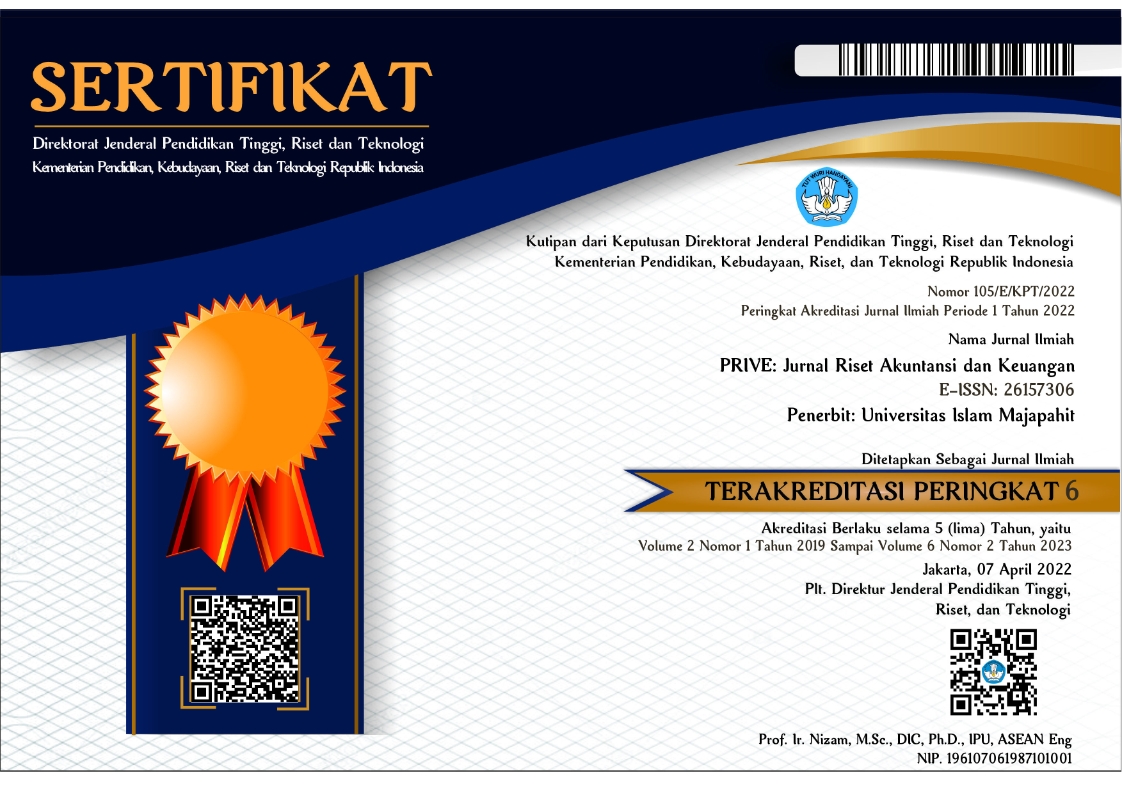Pengaruh Free Cash Flow dan Struktur Aset Terhadap Kebijakan Hutang Dengan Pemoderasi Risiko Bisnis
Keywords:
free cash flow, Asset Structure, Debt Policy And Business RiskAbstract
Agency conflicts can be reduced by monitoring to align the interests of related parties. The existence of this supervision will lead to agency costs. To reduce agency costs, it can be done by increasing assets through debt. Business risk can be used as a foothold in making decisions regarding debt policies for companies. Business risk is influenced by the uncertainty of revenue acquisition for the company. Companies that have a business with business risk are more likely to reduce the amount of debt, because the company does not want to increase the risk of debt repayment difficulties. The greater the risk implies in the small debt for the company. This is certainly influenced by the company's ability to repay debt due to uncertainty (volatility) of income or profits that can be achieved by the company. The sample used was 70. The results of the study concluded that business risk variables could simultaneously be a moderating effect of free cash flow and asset structure on debt policy. this can be seen from an increase in influence of 0.013 or 1.3%. Partially business risk cannot be used as a moderating effect of free cash flow on debt policy. But business risk can be partially used as a moderating effect of asset structure on debt policy
References
Brigham, E.F.dan Gapenski, LouisC. 1996. “Intermadiate finance management” (5th ed.). Harbor Drive: The Dryden Press.
Erkaningrum Indri, F. 2013.” Interactions Among Insider Ownership, Dividend Policy, Debt Policy, Investment Decision, And Business Risk”. Journal of Indonesian Economy and Business Volume 28, Number 1, 2013, 132 – 148
Ghozali, Imam. 2009. “Aplikasi Analisis Multivariate dengan Program SPSS “.Semarang : UNDIP
Ghozali, Iman. 2007. “Teori akuntansi”. Cetakan III. Badan Penerbit Universitas Diponegoro.
Hanafi, Mamduh. (2004). “Manajemen Keuangan”, BPFE, Yogyakarta
Hastalona, Dina. 2013. “Analisis Faktor-Faktor yang Mempengaruhi kebijakan hutang”. Jurnal Keuangan dan Bisnis. Vol 5. No. 1 :60-72.
Hidayat, Muhammad, Arif. 2013. “Prediksi Financial DistressPerusahaan Manufaktur di Indonesia”. Skripsi Fakultas Ekonomika dan Bisnis Universitas Diponegoro.
Ichsan. 2013. “Teori Keagenan (Agency Theory) “ (https://bungrandhy.wordpress.com/2013/01/12/teori-keagenan-agency-theory/)
Modigliani, Franco and Miller, Merton H. 1963. “Corporate Income Taxes and the Cost of Capital: A Correction”. The American Economic Review, Vol. 53, No. 3 (Jun., 1963), Published by: American Economic URL: http://www.jstor.org/stable/1809167
Murhadi, Werner R. 2013. “Analisis Laporan Keuangan, Proyeksi dan Valuasi Saham”. Jakarta: Salemba Empat
Myers, S.C. (1984). “Capital Structure Puzzle”. Journal of Finance39, 1-33.
Naini, D. I., dan Wahidahwati. 2014. "Pengaruh free cash flow dan Kepemilikan Institusional Terhadap kebijakan hutang dan Nilai Perusahaan". Jurnal Ilmu & Riset Akuntansi, Vol 3(4), Pp 1-17
Penman, Stephen H. 2007. “Financial Statement analysis and Security Valuation” .3rd Edition: McGraw-Hill.
Setiana, Esa. 2013. “Pengaruh free cash flow Dan Kepemilikan Manajerial Terhadap kebijakan hutang Pada Perusahaan Manufaktur Yang Terdaftar Di Bursa Efek Indonesia (BEI)”. Jurnal Telaah Akuntansi, 15 (01). pp. 16-33. ISSN 1693-6760
Setyawati. 2014.”Analisis Pengaruh Struktur Kepemilikan, Dividen, struktur aset”Dan Profitabilitas Terhadap kebijakan hutang Perusahaan (Studi Empiris Pada Perusahaan Manufaktur yang Terdaftar di Bursa Efek Indonesia Tahun 2010-2012)”.SkripsiUniversitas Diponegoro.
Van Horne, James C dan Wachowicz, John M. Jr. 2013. “Prinsip-prinsip Manajemen Keuangan”. Edisi Indonesia. Penerbit Salemba Empat. Jakarta.
Van Horne, James C. dan Wachowicz, John M. Jr. 2014. “Primsip-prinsip Manajemen Keuangan (Fundamentals of Financial Management)”. Edisi 13 Buku 2. Jakarta: Salemba Empat
Wahidahwati. 2002. “Pengaruh Kepemilikan Manajerial Dan KepemilikanInstitusional Pada kebijakan hutang Perusahaan: Sebuah Perspektif Theory Agency ”, Jurnal Riset Akuntansi Indonesia, Vol. 5, No.1, Januari:Hal 1-16.
Yeniatie dan Destriana, Nicken. 2010. “Faktor-Faktor yang Mempengaruhi kebijakan hutang pada Perusahaan Non Keuangan yang Terdaftar di Bursa Efek Indonesia”. Jurnal Bisnis dan Akuntansi.Vol. 12. No. 1. April. hlm. 1-16







